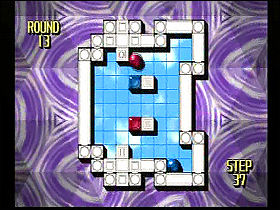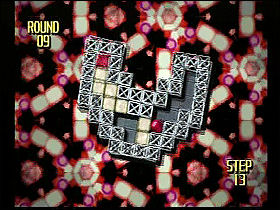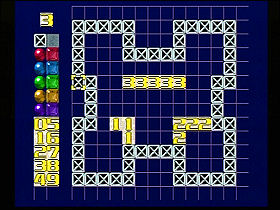
 The Game: A rotating box sits in the center of the screen, containing a maze, at least one mobile ball, and other moving elements such as sliding bars or boxes. Using the left and right D-pad buttons, players rotate the entire box, which will cause any of the mobile pieces to obey the laws of gravity and fall in that direction. The object of the game is to get all of the balls into contact with the jewel of the same color at the other end of the maze – which may not be as easy as it sounds! (Natsume, 2002)
The Game: A rotating box sits in the center of the screen, containing a maze, at least one mobile ball, and other moving elements such as sliding bars or boxes. Using the left and right D-pad buttons, players rotate the entire box, which will cause any of the mobile pieces to obey the laws of gravity and fall in that direction. The object of the game is to get all of the balls into contact with the jewel of the same color at the other end of the maze – which may not be as easy as it sounds! (Natsume, 2002)
Memories: As Sony eased its restrictions on Playstation licensing toward the end of the console’s life span (at this point, the PS2 was already on the market), heaps of cheap PS1 games hit store shelves. Some of these were pure shovelware, hastily cranked out to make a buck off that segment of the gaming populace that couldn’t afford to upgrade to the PS2. Quite a few were quickly-done localizations of games that had already been released – often as budget titles from the outset – in Japan. Turnabout is in the latter category, and unlike quite a few of the glut of games released in the PS1’s twilight, it’s a lot of fun.
 Turnabout isn’t a new idea, not by a long stretch: it’s a virtual version of a series of puzzles that could just as easily be built physically. But it’s very easy to control (aside from occasional use of the X button and/or the start button for calling up or navigating in-game menus, the left and right D-pad keys are all you need), and it’s pleasing enough to the eye and ear. Color-shifting, kaleidoscopic backgrounds fill out the portions of the screen not taken by the maze box itself, and while I won’t claim that the music loops didn’t ever get on my nerves, it took quite a while before they did. When the pieces in the maze are sent tumbling, the resulting on-screen movement and appropriately chunky sound effects lend the game a nice realism amid all the surreal elements.
Turnabout isn’t a new idea, not by a long stretch: it’s a virtual version of a series of puzzles that could just as easily be built physically. But it’s very easy to control (aside from occasional use of the X button and/or the start button for calling up or navigating in-game menus, the left and right D-pad keys are all you need), and it’s pleasing enough to the eye and ear. Color-shifting, kaleidoscopic backgrounds fill out the portions of the screen not taken by the maze box itself, and while I won’t claim that the music loops didn’t ever get on my nerves, it took quite a while before they did. When the pieces in the maze are sent tumbling, the resulting on-screen movement and appropriately chunky sound effects lend the game a nice realism amid all the surreal elements.
One warning: after about 20 puzzles, I found myself getting a little bit dizzy from the constant rotation of the maze box; this is a game where it pays to step away and take a break every once in a while. I’m reminded of Dave Theurer’s story about how the early drafts of Tempest featured the rest of the screen rotating instead of the player, making some play-testers sick. The very nature of Turnabout demands that the entire screen rotate, but it can be dizzying after a while.
 A really neat feature of Turnabout that goes almost completely unannounced on the game’s packaging is a simple system for editing a series of your own puzzles and saving them to a memory card. Puzzles are edited with a simple interface where the elements of the board are “painted” onto a grid, and all of the elements of the pre-programmed puzzles – multiple moving blocks and more – are available. Even this part of Turnabout is entertaining, as one quickly learns the ins and
A really neat feature of Turnabout that goes almost completely unannounced on the game’s packaging is a simple system for editing a series of your own puzzles and saving them to a memory card. Puzzles are edited with a simple interface where the elements of the board are “painted” onto a grid, and all of the elements of the pre-programmed puzzles – multiple moving blocks and more – are available. Even this part of Turnabout is entertaining, as one quickly learns the ins and  outs of creating a workable puzzle (after some trial-and-error with unsolvable ones).
outs of creating a workable puzzle (after some trial-and-error with unsolvable ones).
For a budget title, Turnabout offers a lot of replay value. As simple and old-school as it may be, it’s a lot of fun.